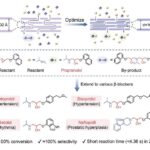
A recent breakthrough cohort study published in JAMA Network Open has revealed critical insights into the intricate relationship between environmental burden and cancer incidence rates across diverse racial and ethnic populations. This comprehensive investigation emphasizes the pressing need for sustained and targeted community interventions, particularly in minoritized census regions characterized by elevated environmental stressors. The findings underscore the multifactorial etiology of cancer and highlight environmental injustice as a significant contributor to health disparities observed in oncological outcomes.
The research team employed a robust cohort design, leveraging large-scale population data to examine cancer incidence over a defined period. Using advanced statistical modeling and environmental exposure metrics, the study dissected the correlation between various parameters of environmental burden—including air and water pollution, proximity to hazardous waste sites, and industrial emissions—and their influence on cancer emergence in different demographic groups. This methodological precision ensures that observed associations are not spurious but reflect genuine epidemiological patterns that warrant urgent public health attention.
Central to the study’s novelty is its exploration of how racial and ethnic composition intersects with environmental adversity to compound cancer risk. The data reveal that minoritized communities, often residing in regions with intensified environmental hazards, exhibit disproportionately higher cancer incidence rates. This spatial and demographic clustering of risk points to systemic inequalities that perpetuate environmental injustices, suggesting that socioeconomically marginalized populations bear a heavier burden of carcinogenic exposures resulting from historical and ongoing environmental disinvestment.
.adsslot_NGSkTami1O{ width:728px !important; height:90px !important; }
@media (max-width:1199px) { .adsslot_NGSkTami1O{ width:468px !important; height:60px !important; } }
@media (max-width:767px) { .adsslot_NGSkTami1O{ width:320px !important; height:50px !important; } }
ADVERTISEMENT
Importantly, this study transcends mere correlative analysis by probing potential mechanistic pathways through which environmental toxins might initiate or promote carcinogenesis. The authors discuss how chronic exposure to specific pollutants, such as polycyclic aromatic hydrocarbons, heavy metals, and particulate matter, may induce genetic mutations, epigenetic alterations, and chronic inflammation—all recognized precursors to malignant transformation. These biological insights enhance the causal narrative and open avenues for future research aimed at targeted molecular interventions.
Furthermore, the comprehensive geographic analysis elucidated regional disparities in environmental burden and cancer outcomes. By integrating census tract-level data with environmental exposure indices, the study identifies “hotspots” where public health infrastructures may need reinforcement. Such granular data equip policymakers and stakeholders with actionable intelligence to prioritize environmental remediation efforts and health promotion programs where they are most desperately needed.
From a public health perspective, the study’s implications are profound. It advocates for incorporating environmental justice frameworks into cancer prevention strategies, emphasizing that addressing environmental determinants of health is not only a moral imperative but also a clinical necessity. Targeted community interventions designed to mitigate exposure, enhance screening, and increase healthcare access could substantially reduce cancer disparities and improve survival rates within vulnerable populations.
A notable strength of this work lies in its multidisciplinary approach, integrating epidemiology, environmental science, social determinants of health, and molecular oncology. By bridging these domains, the study paints a holistic portrait of cancer risk that moves beyond genetics and lifestyle factors to acknowledge the pervasive role of environmental injustice. Such integrative frameworks are essential for designing comprehensive cancer control policies in the 21st century.
In addition, the study calls for sustained surveillance of environmental exposures coupled with robust cancer registries to monitor evolving trends in disease burden. Continuous data collection and analysis will enable early detection of emerging risk patterns, inform adaptive interventions, and facilitate equitable resource allocation. The dynamic nature of environmental risk factors—amplified by ongoing industrial activity and climate change—necessitates vigilance to preemptively address new challenges to public health.
The researchers also stress the importance of community engagement and empowerment in addressing environmental health risks. Programs that foster local participation, education, and advocacy can amplify the effectiveness of interventions and ensure that they are culturally sensitive and contextually relevant. Such bottom-up approaches complement top-down policy measures, creating synergistic pathways for sustained impact.
Complementing epidemiologic findings, the article discusses the potential for precision public health approaches that leverage geospatial technologies, biomonitoring, and genetic profiling to identify high-risk individuals and tailor preventive measures. These cutting-edge tools, while promising, must be judiciously applied with attention to ethical, privacy, and equity considerations to avoid exacerbating existing disparities.
Ultimately, this pioneering study adds to a growing body of evidence that environmental factors are pivotal determinants of cancer risk, intricately intertwined with social and racial inequities. Addressing these complex challenges requires multidisciplinary collaboration, innovative research methodologies, and an unwavering commitment to environmental justice. The path forward demands integrated policies that transform vulnerable neighborhoods into healthy environments, breaking the vicious cycle of exposure and disease.
As cancer remains a leading cause of morbidity and mortality worldwide, translating these insights into actionable interventions offers hope for reducing the disproportionate burden borne by marginalized communities. By shining a spotlight on environmental burden as a critical nexus of cancer risk, this study galvanizes a paradigm shift toward equity-driven cancer prevention and control—a transformation urgently needed to ensure health for all.
Subject of Research: Environmental burden and its association with cancer incidence rates across racial and ethnic populations.
Article Title: Not provided.
News Publication Date: Not provided.
Web References: Not provided.
References: (doi:10.1001/jamanetworkopen.2025.16740)
Image Credits: Not provided.
Keywords: Cancer risk, environmental burden, racial and ethnic composition, cancer incidence, environmental justice, cohort study, epidemiology, public health, oncology.
Tags: advanced statistical modeling in health studiesair and water pollution effects on healthcancer burden in diverse neighborhoodscancer incidence ratescommunity interventions for cancerenvironmental injustice and health disparitiesenvironmental stressors and healthepidemiological patterns in cancer researchhazardous waste site proximity and cancerminority populations and environmental hazardsracial diversity and cancer risktargeted public health strategies


